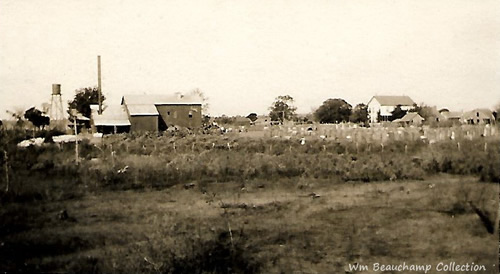|
 |
Remembering
Leesville
by Murray
Montgomery
I guess it comes as no surprise to most people that I am very curious
about the past.
And I'm not only curious about events that happened long ago, but
I often ponder the history of old homes, buildings, and forgotten
places. When I'm out driving and see an old deserted house, I tend
to wonder about the family that lived there. How many babies were
born there? Did someone die there? Were there ever any weddings held
in that old place?
I get the same feeling when I see a community that is not quite as
well off as it once was — I question, what brought people to this
place? What did they do to survive and why did they leave?
Texas has a number of towns that were once flourishing places with
colorful pasts. But for some reason or another, many of the residents
moved on and all that was left were memories of that special time,
so long ago.
One such community located in Gonzales
County had me wanting to know more about how it came to be. So
I turned to my favorite source to find some information about Leesville,
Texas.
According to The Handbook of Texas, Leesville was originally
located on the east bank of Castleman's Creek. The stream later
became known as O'Neill Creek in honor of the Henry O'Neill
family (another source has the spelling as O'Neal). Those folks arrived
in the area sometime in the 1830s.
The town was initially known as Capote, named after the nearby
Capote Hills. One of the first businesses began there in the 1860s
when Sylvester A. Hubbard built an ox-powered treadmill to grind corn
and saw lumber. In 1868, Daniel Brown and his brother opened the first
general merchandise store to be located at old Capote. About the same
time, a brick kiln along with a saddletree and stirrup factory began
operations.
Sometime between 1868 and 1887, Mr. Newburn H. Guinn divided land
on the west bank of the creek into town lots and sold them to various
businesses. In about 1870, Guinn decided to name the town Leesburg,
after his daughter, Lee. When the town applied for a post office however,
they had to do so under the original name of Capote — there was already
a Leesburg in Texas at the time. The post office opened in 1873. Finally,
in 1874, the town became known as Leesville.
The citizens decided that education would be the first priority and
they constructed a one-room, redbrick schoolhouse. Mrs. M.C. Hubbard
deeded a quarter acre of land to the stockholders of the Leesburg
(Leesville) Male and Female Institute on January 21, 1873.
At one time the school system had an accredited high school. It was
later consolidated with the Nixon Independent School District. The
last high school class graduated in 1947, but four elementary grades
were taught at Leesville until 1951.
The economy of Leesville depended mostly on cutting and selling oak
as well as, other hardwood for use as building material. The residents
also raised grain and cattle. Cotton became the big money crop after
the Civil War, with three cotton gins operating at the same time.
In later years, ranching along with peanut and melon farming contributed
to the local economy.
In 1866, The Methodist Episcopal Church, South, organized. In December
of 1871 the church hosted the annual West Texas Conference, in a brand
new building. The Leesville Baptist Church was organized in 1876 and
the Leesville Church of Christ originated in 1911. The founding of
the Colored Methodist Episcopal Church and the Mexican Baptist Church
soon followed.
Evidently the population of Leesville never surpassed 400. It grew
to that number between 1904 and the 1920s. It went down to 300 in
the 1930s. On June 30, 1936, over 26 inches of rain devastated the
town and the surrounding area. After the flood, many people moved
out. Although some businesses were rebuilt a half mile west of the
original site on Highway 80 — the flood signaled an end to any future
growth for the town.
Leesville still exists, to some extend, and although it may not be
the thriving place that it once was, before the great flood in 1936
— the memories remain for those folks who were brought up there and
the people who still call Leesville, home.
© Murray
Montgomery
Lone
Star Diary October 15, 2004 Column |
Note:
The Handbook of Texas credits Delle Colwell Brown with compiling the
information about Leesville. Other material came from: The History
of Leesville written as a thesis in 1941, by Virgil Mahan, for Southwest
Texas State Teachers College.
Author: Murray Montgomery is a photographer and writer based in Hallettsville,
Texas
Lone Star Diary appears regularly in these Texas newspapers: The Gonzales
Inquirer, the Hallettsville Tribune Herald, the Moulton Eagle, and
The Yoakum Herald Times |
| Texas
Escapes, in its purpose to preserve historic, endangered and vanishing
Texas, asks that anyone wishing to share their local history, stories,
landmarks and recent or vintage photos, please contact
us. |
|
|

 Texas
Gulf Coast
Texas
Gulf Coast East
Texas
East
Texas Central
Texas North
Central
Texas North Central
Texas South
Central
Texas South Texas
Panhandle
Texas
Panhandle South
Texas
South
Texas Texas
Hill Country
Texas
Hill Country West
Texas
West
Texas Texas
Ghost Towns
Texas
Ghost Towns Texas
Counties
Texas
Counties